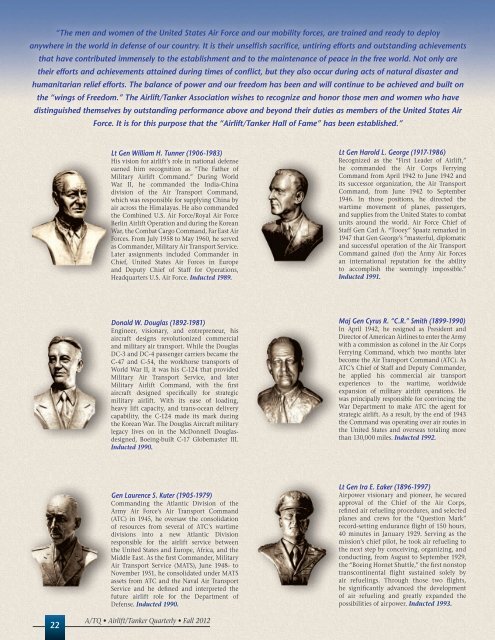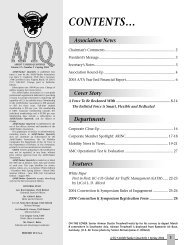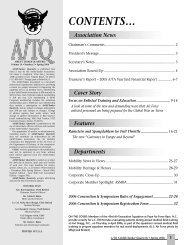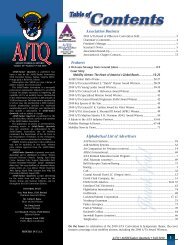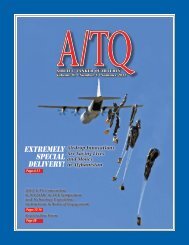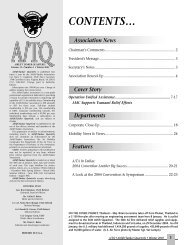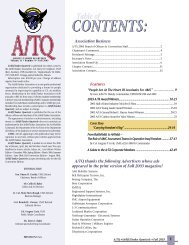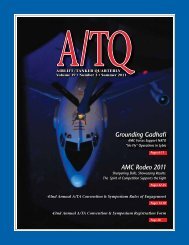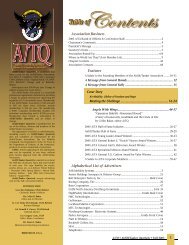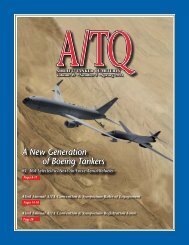A/TQ covers - Airlift/Tanker Association
A/TQ covers - Airlift/Tanker Association
A/TQ covers - Airlift/Tanker Association
You also want an ePaper? Increase the reach of your titles
YUMPU automatically turns print PDFs into web optimized ePapers that Google loves.
“The men and women of the United States Air Force and our mobility forces, are trained and ready to deploy<br />
anywhere in the world in defense of our country. It is their unselfish sacrifice, untiring efforts and outstanding achievements<br />
that have contributed immensely to the establishment and to the maintenance of peace in the free world. Not only are<br />
their efforts and achievements attained during times of conflict, but they also occur during acts of natural disaster and<br />
humanitarian relief efforts. The balance of power and our freedom has been and will continue to be achieved and built on<br />
the “wings of Freedom.” The <strong>Airlift</strong>/<strong>Tanker</strong> <strong>Association</strong> wishes to recognize and honor those men and women who have<br />
distinguished themselves by outstanding performance above and beyond their duties as members of the United States Air<br />
Force. It is for this purpose that the “<strong>Airlift</strong>/<strong>Tanker</strong> Hall of Fame” has been established.”<br />
Lt Gen William H. Tunner (1906-1983)<br />
His vision for airlift’s role in national defense<br />
earned him recognition as “The Father of<br />
Military <strong>Airlift</strong> Command.” During World<br />
War II, he commanded the India-China<br />
division of the Air Transport Command,<br />
which was responsible for supplying China by<br />
air across the Himalayas. He also commanded<br />
the Combined U.S. Air Force/Royal Air Force<br />
Berlin <strong>Airlift</strong> Operation and during the Korean<br />
War, the Combat Cargo Command, Far East Air<br />
Forces. From July 1958 to May 1960, he served<br />
as Commander, Military Air Transport Service.<br />
Later assignments included Commander in<br />
Chief, United States Air Forces in Europe<br />
and Deputy Chief of Staff for Operations,<br />
Headquarters U.S. Air Force. Inducted 1989.<br />
Lt Gen Harold L. George (1917-1986)<br />
Recognized as the “First Leader of <strong>Airlift</strong>,”<br />
he commanded the Air Corps Ferrying<br />
Command from April 1942 to June 1942 and<br />
its successor organization, the Air Transport<br />
Command, from June 1942 to September<br />
1946. In those positions, he directed the<br />
wartime movement of planes, passengers,<br />
and supplies from the United States to combat<br />
units around the world. Air Force Chief of<br />
Staff Gen Carl A. “Tooey” Spaatz remarked in<br />
1947 that Gen George’s “masterful, diplomatic<br />
and successful operation of the Air Transport<br />
Command gained (for) the Army Air Forces<br />
an international reputation for the ability<br />
to accomplish the seemingly impossible.”<br />
Inducted 1991.<br />
Donald W. Douglas (1892-1981)<br />
Engineer, visionary, and entrepreneur, his<br />
aircraft designs revolutionized commercial<br />
and military air transport. While the Douglas<br />
DC-3 and DC-4 passenger carriers became the<br />
C-47 and C-54, the workhorse transports of<br />
World War II, it was his C-124 that provided<br />
Military Air Transport Service, and later<br />
Military <strong>Airlift</strong> Command, with the first<br />
aircraft designed specifically for strategic<br />
military airlift. With its ease of loading,<br />
heavy lift capacity, and trans-ocean delivery<br />
capability, the C-124 made its mark during<br />
the Korean War. The Douglas Aircraft military<br />
legacy lives on in the McDonnell Douglasdesigned,<br />
Boeing-built C-17 Globemaster III.<br />
Inducted 1990.<br />
Maj Gen Cyrus R. “C.R.” Smith (1899-1990)<br />
In April 1942, he resigned as President and<br />
Director of American Airlines to enter the Army<br />
with a commission as colonel in the Air Corps<br />
Ferrying Command, which two months later<br />
become the Air Transport Command (ATC). As<br />
ATC’s Chief of Staff and Deputy Commander,<br />
he applied his commercial air transport<br />
experiences to the wartime, worldwide<br />
expansion of military airlift operations. He<br />
was principally responsible for convincing the<br />
War Department to make ATC the agent for<br />
strategic airlift. As a result, by the end of 1943<br />
the Command was operating over air routes in<br />
the United States and overseas totaling more<br />
than 130,000 miles. Inducted 1992.<br />
Gen Laurence S. Kuter (1905-1979)<br />
Commanding the Atlantic Division of the<br />
Army Air Force’s Air Transport Command<br />
(ATC) in 1945, he oversaw the consolidation<br />
of resources from several of ATC’s wartime<br />
divisions into a new Atlantic Division<br />
responsible for the airlift service between<br />
the United States and Europe, Africa, and the<br />
Middle East. As the first Commander, Military<br />
Air Transport Service (MATS), June 1948- to<br />
November 1951, he consolidated under MATS<br />
assets from ATC and the Naval Air Transport<br />
Service and he defined and interpreted the<br />
future airlift role for the Department of<br />
Defense. Inducted 1990.<br />
Lt Gen Ira E. Eaker (1896-1997)<br />
Airpower visionary and pioneer, he secured<br />
approval of the Chief of the Air Corps,<br />
refined air refueling procedures, and selected<br />
planes and crews for the “Question Mark”<br />
record-setting endurance flight of 150 hours,<br />
40 minutes in January 1929. Serving as the<br />
mission’s chief pilot, he took air refueling to<br />
the next step by conceiving, organizing, and<br />
conducting, from August to September 1929,<br />
the “Boeing Hornet Shuttle,” the first nonstop<br />
transcontinental flight sustained solely by<br />
air refuelings. Through those two flights,<br />
he significantly advanced the development<br />
of air refueling and greatly expanded the<br />
possibilities of airpower. Inducted 1993.<br />
22<br />
A/<strong>TQ</strong> • <strong>Airlift</strong>/<strong>Tanker</strong> Quarterly • Fall 2012


